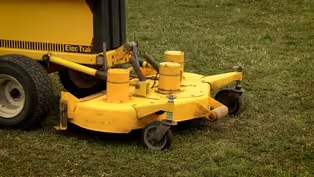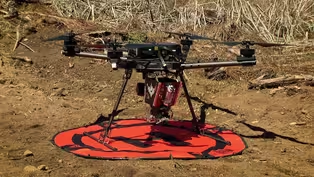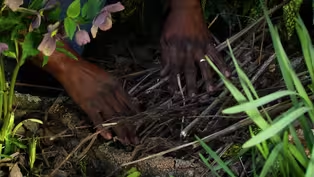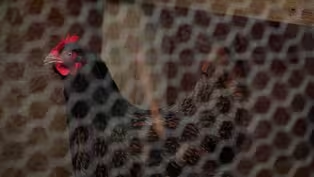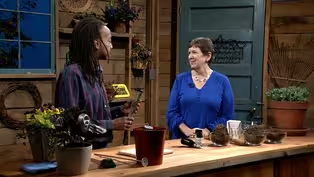Virginia Home Grown
Simple Home Hydroponics
Clip: Season 24 Episode 1 | 6m 33sVideo has Closed Captions
Create a hydroponic system for growing leafy greens indoors
Josh Dusci from Virginia State University visits the studio to demonstrate how to create a simple and affordable hydroponic system using the Kratky method, which does not require a pump. Featured on VHG episode 2401; March 2024.
Problems playing video? | Closed Captioning Feedback
Problems playing video? | Closed Captioning Feedback
Virginia Home Grown is a local public television program presented by VPM
Virginia Home Grown
Simple Home Hydroponics
Clip: Season 24 Episode 1 | 6m 33sVideo has Closed Captions
Josh Dusci from Virginia State University visits the studio to demonstrate how to create a simple and affordable hydroponic system using the Kratky method, which does not require a pump. Featured on VHG episode 2401; March 2024.
Problems playing video? | Closed Captioning Feedback
How to Watch Virginia Home Grown
Virginia Home Grown is available to stream on pbs.org and the free PBS App, available on iPhone, Apple TV, Android TV, Android smartphones, Amazon Fire TV, Amazon Fire Tablet, Roku, Samsung Smart TV, and Vizio.
Providing Support for PBS.org
Learn Moreabout PBS online sponsorshipWelcome, Josh.
You know, I love a man who comes and brings his own salad.
(laughs) >>Oh yeah, we love salad around here for sure, Peggy.
>>We certainly do.
And what beautiful salad at that.
>>Yeah.
>>Yes.
>>But I love this system.
What are you doing here?
(laughs) >>So this is called a hydroponic system right here.
>>Uh-huh.
>>This is specifically a Kratky hydroponic system.
We've designed this DIY using materials that are readily available, and you can have this in home in a small greenhouse, in a garage.
>>Fantastic.
And I see all the components are very simple and available at most any store here in the United States practically.
>>Exactly, yeah.
>>Genius to whoever put this together.
>>Yeah.
>>Well, tell me about it a little bit, 'cause we've got beautiful plants up top.
>>Sure.
Yeah, so we've got a variety of leafy greens here from lettuce, herbs, kale.
They're growing suspended.
>>Uh-huh.
>>So there's actually, there'd be water underneath these roots here.
So you can see beautiful roots.
>>Look at those roots.
>>Oh yeah.
>>I mean, that just tells you just how beautiful and lush and healthy those plants are, 'cause look at those roots.
>>Beautiful, for sure.
>>But if they have water in there, it doesn't today because of the weight issue.
>>That's right, yeah.
>>(laughs) Yeah.
>>But normally they'd have water and they'd be suspended in a nutrient solution where they're getting their nutrients to grow.
And as they're doing that, the water level in the system's actually dropping.
And so they're getting aeration and all the things that plants need to grow, so.
>>Right.
But you know, we, plants need, you know, air, they need, you know, fertilizer and such, but they also need light.
>>That's exactly right, yep.
So the DIY system would not be complete without our light rack here, which actually goes on.
This is all PVC here.
And so would go on just like that.
And your light would hang suspended from there.
And so we've got this LED light here.
>>Which is not light.
I have to tell everybody.
This is not a- >>So.
>>A lightweight thing, but it is light.
(laughs) >>Yeah, yeah, and that's why we've got the thicker PVC there.
So the light is a LED, it's adjustable, which in my opinion is the best thing that you can have.
Because you don't want to have to deal with a very tall light rack where you're having to lift the light up constantly.
So if you're able to adjust the light with the actual light itself, then- >>That's great.
>>Yeah.
Yeah, yeah.
>>Do you have a light monitor?
Something to be able to measure how bright that light is?
'Cause most systems, you're just a few inches off of the top of the plant.
>>Sure.
>>But with that, you're much higher.
So.
>>Yeah.
>>How can you monitor how bright to make your light for your plants to be so healthy?
>>So a good light that you're gonna buy is gonna be, they're gonna have a PAR map, which is essentially, it's already measured everything for you.
>>Okay.
>>So if you are looking at a light and it doesn't have that, I'd say maybe steer away from that, 'cause the actual monitoring is a little bit pricey for the good, you know, quality devices, so.
>>Right, right.
>>Yeah.
>>Well, let's talk about the plants.
>>Yeah, of course.
So primarily leafy greens are gonna be grown in this system.
You can do fruiting crops in hydroponics, but with this system here, we're looking at leafy greens, just because the basin is a little bit smaller.
And, you know, we're looking at a really passive system here.
And so a tomato or pepper, something like that, would require more of a, you know, complete system with pumps, and, you know, things of that nature.
And so.
>>But this is our DIY.
>>Exactly.
>>Well, let's look at these beautiful plants.
>>Yeah.
>>Can we put this one to the side and bring in the little guys?
>>Yeah, of course, yeah.
So- >>Here we go.
>>So this is just a demonstration of essentially what's going on in this system.
So as the plant is a little bit smaller, the roots are more or less fully submerged in the water.
>>Right.
>>But as it's uptaking its nutrients, which we have over here, which we'll talk about, and the water, it's actually leaving a pocket of air.
So the roots are able to breathe, but then the bottom of the roots are still able to uptake the water and the nutrients.
And so- >>Excellent.
So they still get the amount of moisture they need.
They still get the nutrients, but they also get the oxygen.
>>Exactly.
>>Many people don't realize how important that is for roots to have oxygen.
>>Yep.
>>And that's our soil as well as our water.
>>Yeah.
>>We need to accommodate for that.
>>Oh yeah.
An environment that doesn't have oxygen, you're looking at pathogens, you're looking at just plant issues.
They're not gonna be as efficient, so yeah.
>>Yes, yes.
>>Oxygen is life.
Water, nutrients.
>>It is.
>>Yeah.
>>Absolutely.
And the nutrients, you've got three different types here.
Can you explain them to me?
>>Yeah.
Yeah, of course.
So we've got the three part nutrient solution here.
And so typically whenever you're gonna find nutrients within hydroponics, it's either gonna be pre-mixed liquid, which is what you see here, or it's gonna be more of a granular kind of salt looking type nutrient.
And those, you have a little bit more complex nutrient recipe that you can build with those.
>>Right.
>>With these, these are already pre-mixed.
It's easy.
>>Love it.
>>Yeah.
>>Yeah.
Measure, dump and pour, huh?
>>Exactly.
Yeah.
Don't have to do much.
It's just that recipe's already made for you and you just kind of follow the instructions.
And so I think for this type of system, these pre-mixed nutrients are exactly what you're looking for.
>>And they've got nitrogen, phosphorous, potassium.
>>Yep, yep.
>>And then those are the macronutrients, but they also have the micronutrients in them.
>>Exactly.
>>People don't know that there's the Molybdenum and all those manganese and the M words that we need, so.
>>Yeah, there's 16 of 'em in total.
>>Yes.
>>Yeah.
There's also a couple on the spectrum too that they don't always talk about, but also still can be beneficial for plant growth.
>>Absolutely.
>>Silicon is one of 'em.
Yeah.
>>Real quick.
>>Yeah.
>>We talked about oxygen in the beginning when the water is high.
>>Yeah.
>>You've gotta have some way of introducing oxygen.
And we just have a few minutes, a little bit time left.
>>Yeah, so this is just a little aquarium pump here that we have.
We've got a check valve on it.
That prevents any water if your power were to go out or anything like that.
>>Oh, from siphoning back?
>>From siphoning, yeah.
'Cause you wanna keep that pump running, right?
>>Oh, yes.
>>So, and then we've got a small airstone on it too.
And so that's providing whenever the plant's real small, oxygen to the roots, so, yep.
>>Exactly.
And then super quick, the meters?
>>Yeah.
So these are just meters right here measuring EC, pH, essentially those are water quality parameters that plants, you know, are looking for and that you need to monitor as you're growing the plants.
But if you follow that pre-mixed nutrient solution, you should be pretty good to go.
So yeah.
>>Well, Josh, this is fascinating.
Such simple tools, such simple equipment, and having the right nutrient balances, people will be able to grow their own salad in their house, or even in schools.
>>That's what we hope for, Peggy, yeah.
>>Oh, it'd be kind of fun to get 'em in every classroom.
>>(laughs) That's right.
>>Well, thank you.
>>Of course.
Video has Closed Captions
Clip: S24 Ep1 | 26m 46s | Explore green technology for forests and home gardens! (26m 46s)
Video has Closed Captions
Clip: S24 Ep1 | 7m 34s | Learn how the Virginia Department of Forestry is taking forest management to new heights (7m 34s)
Video has Closed Captions
Clip: S24 Ep1 | 8m 59s | Discover a line of electric lawn care equipment from the 1970s (8m 59s)
Video has Closed Captions
Clip: S24 Ep1 | 3m 10s | Add space in your landscape for native pollinators (3m 10s)
Video has Closed Captions
Clip: S24 Ep1 | 2m 42s | Composting chicken manure creates a rich additive for garden soil (2m 42s)
Video has Closed Captions
Clip: S24 Ep1 | 5m 52s | Simple tools to improve your garden soil (5m 52s)
Providing Support for PBS.org
Learn Moreabout PBS online sponsorship

- Home and How To

Hit the road in a classic car for a tour through Great Britain with two antiques experts.












Support for PBS provided by:
Virginia Home Grown is a local public television program presented by VPM
